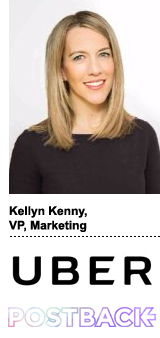
Uber’s rider-focused ad spend has increased twentyfold in the last year and a half.
“The onus that puts on us to be really clever in our targeting and thoughtful is incredibly high,” said Kellyn Kenny, Uber’s VP of marketing, speaking at Tune’s Postback conference in Seattle on Thursday.
Although user acquisition is still a top priority (as of last year, the app had 40 million monthly active riders worldwide), at Uber’s scale, re-engagement drives efficiency.
“[We] need to harvest as much business from existing customers as humanly possible,” Kenny said.
Although static mobile display worked well in the past to gently remind users hovering in the high-intent category to begin a trial, “when you 20x your investment, you need to do more than nudge people to move down the funnel,” Kenny said.
For example, Uber is getting smarter about customer lifetime value by monitoring the particulars around different acquisition scenarios.
Uber tracks the channel a new user came in on, in which city that user downloaded the app and how both of those vary based on daypart and the user’s profile.
That info comes in handy for strategic forecasting, Kenny said, so that Uber can “have a read on how this consumer will behave.”
Uber also keeps tabs on the weather at the time of sign-up as a key indicator of future potential behavior.
“When we want to retarget people, it’s helpful to know that if, when they downloaded the app and took their first trip, it was raining,” Kenny said.
And if it’s raining outside when someone orders a car, that person needs to be serviced quickly.
But no one, regardless of the weather, wants to wait very long before a car shows up, which is why Uber focuses on the balance of riders and drivers in each market.
If there aren’t enough drivers on the road, prices go up and users have longer wait times. On the flip side, if there aren’t enough riders in a market, drivers get frustrated because they’re not making any money.
For that reason, Uber has been tipping more of its ad budget into hyperlocal marketing rather than spending it on the national stage.
National ad spend can actually mask market imbalance, Kenny said. Although the average cost per sign-up or the cost per first trip might initially look good after a national campaign, Uber needs to be more strategic about the rider-to-driver ratio in particular markets.
Although the “sugar high” of national spend looks good, Uber has been steadily shifting a “significant portion” of its ad spend from national to local, Kenny said.
“The national numbers look less sexy now,” she said. “But the health of the marketplace has gone way up.”
This post was syndicated from Ad Exchanger.

More Stories
5 Ways Brands Can Weather a Tariff Storm as Consumer Spending Shifts Toward Value
Creativity shines
Hilton Uses Social Listening to Showcase ‘Superior’ Stays